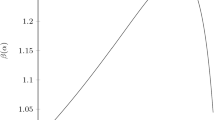Abstract
The communication mix is a relevant decision issue for an organization that plans the advertising campaign for a fixed future event. It is assumed that the objectives of the organization are to minimize the cost of the advertising campaign and to drive the final demand as close as possible to a target value. Two different advertising channels are available: the first affects deterministically the consumers’ demand, whereas the second presents some stochastic aspects which are out of decision-maker’s control. Some recent mathematical developments on the stochastic linear quadratic control problem allow to formulate and solve some interesting instances of the problem. A comparative analysis of the efficiency of deterministic and stochastic controls is done and the optimal feedback policies are discussed. The trade-off between efficiency and risk of an advertising channel is essential to understand the features of the optimal solutions.
Similar content being viewed by others
References
Ait Rami M, Moore JB, Zhou XY (2001) Indefinite stochastic linear quadratic control and generalized differential riccati equation. SIAM J Control Optim 40(4):1298–1311
Buratto A (2002) Budget allocation in the integrated ommunication mix. Rendiconti degli studi Economici e Quatitativi, pp 89–104
Buratto A, Favaretto D (2002) Optimal communication mix to maximize brand image. Ricerca Operativa 103/104:33–50
Buratto A, Viscolani B (2002) New product introduction: goodwill, time and advertising cost. Math Methods Oper Res (55):55–68
Chen S, Li X, Zhou XY (1998) Stochastic linear quadratic regulator with indefinite control weight costs. SIAM J Control Optim 36(5):1685–1702
Feichtinger G, Hartl RF, Sethi SP (1994) Dynamic optimal control models in advertising: recent developments. Manage Sci 40(2):195–226
Grosset L, Viscolani B (2004) Advertising for a new product introduction: a stochastic approach. TOP 12(1):149–168
Jørgensen S, Zaccour G (1999) Equilibrium pricing and advertising strategies in a marketing channel. J Optim Theory Appl 102(1):111–125
Nerlove M, Arrow JK (1962) Optimal advertising policy under dynamic conditions. Economica 29:129–142
Raman K (1990) Stochastically optimal advertising policies under dynamic conditions: the ratio rule. Optim Control Appl Methods 11:283–288
Rao RC (1986) Estimating continuous time advertising-sale models. Mark Sci 5(2):125–142
Runggaldier W (2001) The choice of the loss function for a decision problem under uncertainty as a compromise between representativity and computational tractability. In: 20-th ESRcDA International Seminar on Decision Analysis, Rome, pp 141–148
Sethi SP (1990) Deterministic and stochastic optimisation of a dynamic advertising model. Optim Control Appl Methods 4(2):179–184
Tapiero CS (1975) On-line and adaptive optimum advertising control by a diffusion approximation. Oper Res 23(5):890–907
Tapiero CS (1978) Optimum advertising and goodwill under uncertainty. Oper Res 26(3):450–463
Tapiero CS (1979) A generalization of the Nerlove-Arrow model to multi-firms advertising under uncertainty. Manage Sci 25(9):907–915
Tapiero CS (1982) Optimal control of a stochastic model of advertising. In: Feichtinger G (ed) Optimal control theory and economic analysis. North-Holland, Amsterdam, pp 287–299
Tapiero CS (1983) Stochastic diffusion model with advertising and word-of-mouth effects. Eur J Oper Res (12):348–356
Tapiero CS (1988) Applied stochastic models and control in management. North-Holland, Amsterdam
Varian HR (1984) Microeconomic analysis. Norton, New York
Yong J, Zhou XY (1999) Stochastic controls, Hamiltonian systems and HJB equations. Springer, Berlin Heidelberg New York
Author information
Authors and Affiliations
Corresponding author
Additional information
This study was supported by MIUR and University of Padua.
Rights and permissions
About this article
Cite this article
Buratto, A., Grosset, L. A communication mix for an event planning: a linear quadratic approach. 14, 247–259 (2006). https://doi.org/10.1007/s10100-006-0002-y
Published:
Issue Date:
DOI: https://doi.org/10.1007/s10100-006-0002-y




